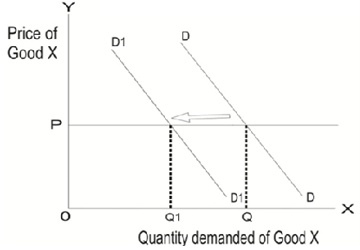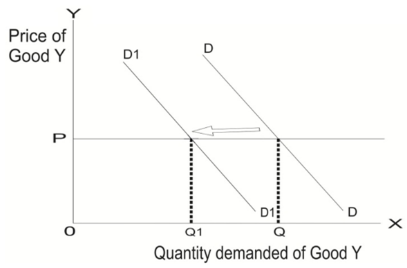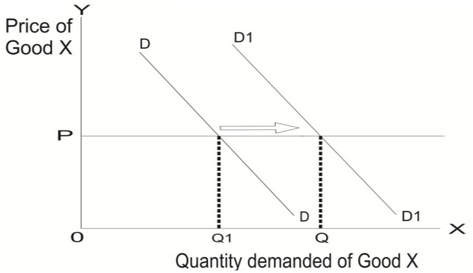
(a)
To explain:
The impact on
Answer to Problem 1CACQ
There will be fall in demand of goods X.
Explanation of Solution
There is a leftward shift in demand curve. This is because when there is decrease in income, it leads to fall in demand. This is because the commodity is normal goods. So, there is a positive relation between demand and income.
In the below diagram, DD is the initial demand curve and P is the

Figure 1: Decrease in the income of consume shifts demand curve leftwards
Thus, when income of the consumer decreases, the demand of goods X decreases from Q to Q1 keeping price of goods X fixed.
Normal Goods:
The goods are said to be a normal goods when there is a positive relation between income and demand of a commodity.
Inferior goods:
The goods are said to be inferior goods when there is an inverse relation between income and demand of a commodity.
(b)
To explain:
The impact on demand for goodsY due to increase in income.
Answer to Problem 1CACQ
There will be fall in demand of goodsY.
Explanation of Solution
There is a leftward shift in demand curve. This is because when there is increase in income, it leads to fall in demand as goods is an inferior goods. So, there is an inverse relation between demand and income, thus decreasing the demand of inferior goods.
In the below diagram, DD is the original demand curve, P is the initial price line. As income of a consumer increases, it leads to leftward shift of demand curve from DD to D1. This is because goods in question is an inferior goods.
Figure 2: Increase in the income of consumer shifts demand curve of Goods Y (Inferior Goods) leftwards

Thus, when income of the consumer increases, the demand of goods Y decreases from Q to Q1 keeping price of goods Y fixed.
Normal Goods:
The goods are said to be a normal goods when there is a positive relation between income and demand of a commodity.
Inferior goods:
The goods are said to be inferior goods when there is an inverse relation between income and demand of a commodity.
(c)
To explain:
The impact on demand for goods X due to increase in price of goods Y.
Answer to Problem 1CACQ
The demand for goods X increases when price of goods Y increases.
Explanation of Solution
It is given that the goods X and goods Y are substitute goods which mean that consumer can use these goods in place of one another. Substitute goods are those goods which are used in place of each other. Price of goods X leads to increase in demand for goods Y.
Goods are substitutable in nature. Demand of a goods is affected when price of related goods changes.
The diagram given below shows the effect of increase in the price of goods Y on the demand of goods X.
Figure 3: Demand curve of goods X shifts rightwards as price its substitute goods (Goods Y) increases.

In Figure-3, DD is the original demand curve, P is the price line. As there is an increase in price of goods Y, it leads to shift in demand curve from DD to D 1. Therefore, demand for goods X increases when price of goods Y increases.
Substitute goods:
Substitute goods are those which can be used in place of each other. These goods have a positive cross elasticity.
Complementary goods:
Complementary goods are those which are used together. These goods have negative cross elasticity.
(d)
To explain:
Whether goods Y is a lower quality product than goods X.
Answer to Problem 1CACQ
No, quality of goodsY cannot be determined.
Explanation of Solution
Inferior goods do not mean it is of sub-standard quality. The goods are said to be inferior in nature when the relationship between income of consumer and the demanded quantity of goods is indirect.
As income of consumer rises, it leads to decrease in demand of a commodity, this is because, consumer shifts its demand to a goods which is better than the goods consumed.
As income falls, it leads to increase in consumption of a goods. So, quality of goods Y cannot be determined.
Normal Goods:
The goods are said to be a normal goods when there is a positive relation between income and demand of a commodity.
Inferior goods:
The goods are said to be inferior goods when there is an inverse relation between income and demand of a commodity.
Want to see more full solutions like this?
Chapter 2 Solutions
EBK MANAGERIAL ECONOMICS & BUSINESS STR
- PART II: Multipart Problems wood or solem of triflussd aidi 1. Assume that a society has a polluting industry comprising two firms, where the industry-level marginal abatement cost curve is given by: MAC = 24 - ()E and the marginal damage function is given by: MDF = 2E. What is the efficient level of emissions? b. What constant per-unit emissions tax could achieve the efficient emissions level? points) c. What is the net benefit to society of moving from the unregulated emissions level to the efficient level? In response to industry complaints about the costs of the tax, a cap-and-trade program is proposed. The marginal abatement cost curves for the two firms are given by: MAC=24-E and MAC2 = 24-2E2. d. How could a cap-and-trade program that achieves the same level of emissions as the tax be designed to reduce the costs of regulation to the two firms?arrow_forwardOnly #4 please, Use a graph please if needed to help provearrow_forwarda-carrow_forward
- For these questions, you must state "true," "false," or "uncertain" and argue your case (roughly 3 to 5 sentences). When appropriate, the use of graphs will make for stronger answers. Credit will depend entirely on the quality of your explanation. 1. If the industry facing regulation for its pollutant emissions has a lot of political capital, direct regulatory intervention will be more viable than an emissions tax to address this market failure. 2. A stated-preference method will provide a measure of the value of Komodo dragons that is more accurate than the value estimated through application of the travel cost model to visitation data for Komodo National Park in Indonesia. 3. A correlation between community demographics and the present location of polluting facilities is sufficient to claim a violation of distributive justice. olsvrc Q 4. When the damages from pollution are uncertain, a price-based mechanism is best equipped to manage the costs of the regulator's imperfect…arrow_forwardFor environmental economics, question number 2 only please-- thank you!arrow_forwardFor these questions, you must state "true," "false," or "uncertain" and argue your case (roughly 3 to 5 sentences). When appropriate, the use of graphs will make for stronger answers. Credit will depend entirely on the quality of your explanation. 1. If the industry facing regulation for its pollutant emissions has a lot of political capital, direct regulatory intervention will be more viable than an emissions tax to address this market failure. cullog iba linevoz ve bubivorearrow_forward
- Exercise 3 The production function of a firm is described by the following equation Q=10,000-3L2 where L stands for the units of labour. a) Draw a graph for this equation. Use the quantity produced in the y-axis, and the units of labour in the x-axis. b) What is the maximum production level? c) How many units of labour are needed at that point? d) Provide one reference with you answer.arrow_forwardExercise 1 Consider the market supply curve which passes through the intercept and from which the market equilibrium data is known, this is, the price and quantity of equilibrium PE=50 and QE=2000. Considering those two points, find the equation of the supply. Draw a graph of this line. Provide one reference with your answer. Exercise 2 Considering the previous supply line, determine if the following demand function corresponds to the market demand equilibrium stated above. QD=3000-2p.arrow_forwardConsider the market supply curve which passes through the intercept and from which the marketequilibrium data is known, this is, the price and quantity of equilibrium PE=50 and QE=2000.a. Considering those two points, find the equation of the supply. b. Draw a graph of this line.arrow_forward
 Economics (MindTap Course List)EconomicsISBN:9781337617383Author:Roger A. ArnoldPublisher:Cengage Learning
Economics (MindTap Course List)EconomicsISBN:9781337617383Author:Roger A. ArnoldPublisher:Cengage Learning









